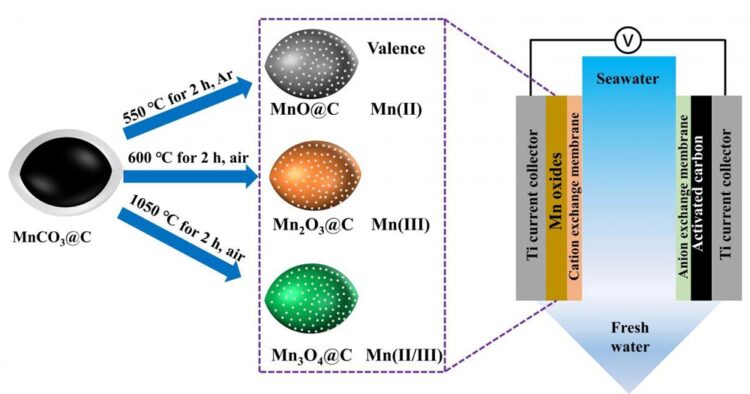High-capacity electrodes by valence engineering developed for desalination

Schematic diagram of MnOx@C electrode preparation and asymmetric membrane CDI device assembly.
Credit: XU Yingsheng
Recently, the researchers from Institute of Solid State Physics, Hefei Institutes of Physical Science (HFIPS) of the Chinese Academy of Sciences, by using valence engineering, developed three manganese oxides as electrodes with different Mn valences for high-performance capacitive desalination.
Reverse osmosis and thermal distillation are widely used to treat salt water with high salt concentration, but they have disadvantages including high energy consumption and high cost.
As an alternative method, capacitive deionization (CDI) technology can remove charged ions from desalt water through electrosorption or pseudocapacitive reaction. However, there are few reports on manganese oxides with lower valence of Mn, compared with the number of reports on MnO2. Hence, whether there is a difference in desalination performance in such different valence states of Mn and the internal reasons are worth exploring.
In this study, because of the high-capacity characteristic of the Faradic electrode, the researchers prepared three different manganese oxide carbon compositions with different valence states of Mn by calcining MnCO3@C precursor under different atmospheres and temperatures, and they combined them with commercial activated carbon electrode to assemble an asymmetric CDI unit. All as-prepared manganese oxides maintained the spindle-like morphology of the precursor.
The results showed that manganese oxides with divalent, trivalent and divalent/trivalent all displayed high salt adsorption capacity and corresponding high salt adsorption rates in 500 mg L-1 NaCl solution, surpassing other advanced carbon materials. Among them, MnO@C indicated the best electrosorption performance and Mn3O4@C has the worst.
The density functional theory (DFT) calculation results proved that the valence state of manganese during Na+ absorption could bring distinct discrepancy in the spatial structure and absorption capacity. Therefore, the researchers concluded that in terms of capacity and stability, the manganese oxides with divalent (MnO@C) was more suitable than trivalent (Mn2O3@C) and divalent/trivalent (Mn3O4@C) manganese oxides for CDI desalination.
The valence engineering provides a novel way for preparing high-performance pseudocapacitive materials for capacitive desalination.
Media Contact
All latest news from the category: Physics and Astronomy
This area deals with the fundamental laws and building blocks of nature and how they interact, the properties and the behavior of matter, and research into space and time and their structures.
innovations-report provides in-depth reports and articles on subjects such as astrophysics, laser technologies, nuclear, quantum, particle and solid-state physics, nanotechnologies, planetary research and findings (Mars, Venus) and developments related to the Hubble Telescope.
Newest articles

Superradiant atoms could push the boundaries of how precisely time can be measured
Superradiant atoms can help us measure time more precisely than ever. In a new study, researchers from the University of Copenhagen present a new method for measuring the time interval,…

Ion thermoelectric conversion devices for near room temperature
The electrode sheet of the thermoelectric device consists of ionic hydrogel, which is sandwiched between the electrodes to form, and the Prussian blue on the electrode undergoes a redox reaction…

Zap Energy achieves 37-million-degree temperatures in a compact device
New publication reports record electron temperatures for a small-scale, sheared-flow-stabilized Z-pinch fusion device. In the nine decades since humans first produced fusion reactions, only a few fusion technologies have demonstrated…





















